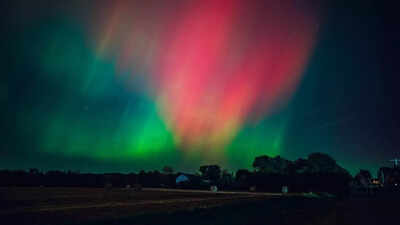ARTICLE AD BOX

The stunning light show is in town again! Get ready for an ethereal night light show, without spending big bucks or turning up at some theatre! Aurora Borealis, also known as the Northern Lights, might appear across the night sky and enchant at least 14 US states this week!According to NOAA’s Space Weather Prediction Center, a minor geomagnetic storm, sparked by solar wind arriving from a coronal hole, is lighting up the possibility of aurora sightings far beyond the usual Arctic zones.
Whether you’re an avid skywatcher or just curious, this is your chance to catch a rare glimpse of swirling greens, pinks, and purples.
What’s happening?
The National Oceanic and Atmospheric Administration (NOAA) forecasts a minor (G1) geomagnetic storm, just enough solar wind energy to stir the Earth's magnetic field and make auroras visible in places where they don’t usually appear. Expect a stunning light show this week, and the best viewing window between 10 p.m. and 4 a.m. local time, with the most vivid light show between 11 p.m. and 5 a.m. EDT. Cherry on top? A late-rising moon keeps skies darker longer, helping those shimmering curtains of light stand out better!
What is the Aurora Borealis?
Aurora borealis, also known as the northern lights, is a natural light display in the sky, primarily seen in high-latitude regions.
It occurs when charged particles from the sun interact with the Earth's atmosphere, producing vibrant colors like green, red, and purple.The aurora borealis is caused by charged particles, mainly electrons and protons, from the sun's solar wind colliding with Earth's magnetosphere. These particles are then guided towards the poles by Earth's magnetic field.The colors observed in the aurora are determined by the specific atmospheric gases and the energy of the colliding particles.
Green light is often associated with oxygen, while red light is also produced by oxygen, and blue and purple light can be seen with hydrogen and helium.Although the aurora borealis is most frequently observed in regions around the Arctic Circle, including countries like Norway, Sweden, Finland, Iceland, Canada, and Alaska, this time several US states are set to witness the magic as well.
Where might the Northern Lights appear?
Not one ot two, this week, the Northern Lights are ready to take the breath away of at least 14 US States. Here’s your breathtaking cosmic map: AlaskaWashingtonIdahoMontanaWyomingNorth DakotaSouth DakotaMinnesotaIowaWisconsinMichiganNew YorkVermontNew HampshireMaineBest viewing tip: Head to the darkest, northern-facing skies possible. Think rural spots, hills, or open fields, for the best chance at spotting the aurora!
Why is the Aurora extending this far south?
It’s ‘Northern’ Lights, right? Not complaining at all, but why exactly is the aurora tiptoeing this far south? The magic begins with coronal holes, dark patches on the sun that release fast solar wind.
When those charged particles hit Earth’s magnetic field, they excite atmospheric gases high above, producing those colorful waves of light. We’re currently in a solar maximum phase, an 11-year cycle where sunspot activity surges, and auroras become more frequent and dramatic.
How to catch the stunning light show
It’s a once-in-a-lifetime chance (even if you witness it for the nth time)! So, make sure you’re prepped to experience the surreal. Here’s your essential viewing guide:Pick the peak hours: Between 10 p.m. and 4 a.m., especially around midnight to 2 a.m.Find a dark spot: Get away from bright city lights and face north for the best view.Bring your camera: Who doesn’t want to capture a once-in-a-lifetime light show! Whether you are a photography enthusiast or just an amateur shooter, get your camera out. Set it to night mode or long exposure. Smartphones can capture more colors than the naked eye. Use tripods for better stability.Check the forecast: Ready to be on to go. Watch NOAA updates and aurora sites for any alerts or changes in activity.Track in real time: Apps like Aurorasaurus crowd-source sightings, helping you know where others are spotting the lights.Whether you're an astronomy enthusiast or just out for a midnight drive, this week’s aurora prospect is a gentle nudge from nature to look up, just soak in the moment, and enjoy. Happy sky watching, and may your night be lit with cosmic color!
This Is Where I Leave You: Official trailer



.png)
.png)
.png)
















 7 hours ago
3
7 hours ago
3










 English (US) ·
English (US) ·